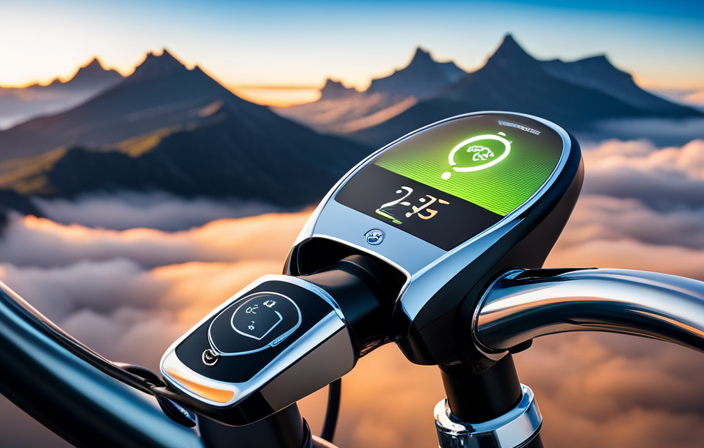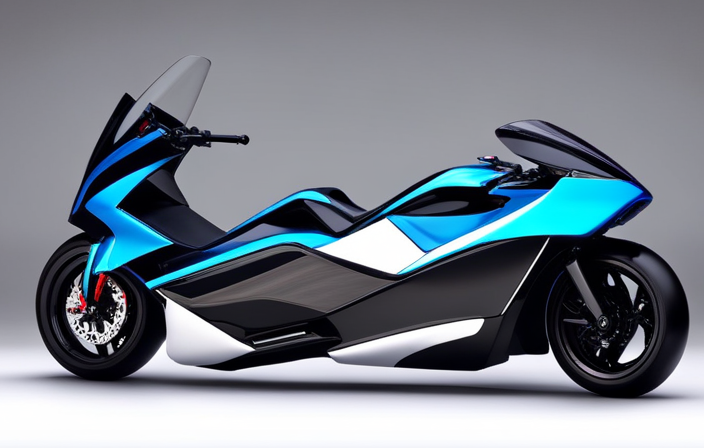Do you ever wonder what ‘PAS’ means on an electric bike? Well, you’re in the right place! In this article, I’ll delve into the world of PAS and its significance in electric bikes.
We’ll explore what PAS stands for, how it works, and the benefits it offers while riding. Whether you’re new to electric bikes or a seasoned rider, understanding PAS is key to maximizing your efficiency and range.
So, let’s jump in and uncover the secrets behind this essential feature.
Key Takeaways
- PAS stands for Pedal Assist System and enhances the electric bike riding experience.
- PAS provides assistance while pedaling, making riding more enjoyable and efficient.
- PAS offers advanced safety features, such as automatic speed regulation and a responsive torque sensor.
- Understanding and adjusting PAS settings based on the terrain can optimize power output and extend battery life.
Introduction to PAS and its importance in electric bikes
PAS, or Pedal Assist System, is an important feature in electric bikes. It allows riders to customize their riding experience by providing assistance when pedaling. Contrary to common misconceptions, PAS does not mean that the bike is fully motor-powered. Instead, it works in conjunction with the rider’s pedaling power to provide an extra boost when needed. Some electric bikes offer multiple PAS levels, giving riders the ability to choose the amount of assistance they want. This customization option is particularly useful when riding on different terrains or facing varying levels of fatigue. Understanding what PAS stands for and its significance in electric bikes is essential for riders to fully enjoy the benefits of electric bike technology.
Explanation of what PAS stands for
An electric bicycle operates with an assistance system known as PAS, which stands for Pedal Assist System. This technology is designed to provide an extra boost of power to the rider while pedaling, making it easier to navigate various terrains and travel longer distances. The advantages of using PAS on an electric bike are numerous.
Here is a brief overview of the benefits:
- Increased Range: With PAS, riders can travel farther without getting tired quickly.
- Enhanced Efficiency: PAS ensures that the rider’s pedaling effort is utilized optimally, resulting in a more efficient and enjoyable riding experience.
- Customizable Assistance Levels: Most electric bikes with PAS offer different assistance levels, allowing riders to choose the amount of assistance they need.
- Better Control: PAS provides a smooth and seamless transition between pedaling and motor assistance, giving riders better control over their bike.
- Health and Fitness Benefits: Using PAS on an electric bike still requires physical effort, providing riders with health and fitness benefits.
Now, let’s delve into an overview of how the pedal assist system works.
Overview of how the Pedal Assist System works
The Pedal Assist System, or PAS, operates by detecting the rider’s pedaling motion and providing a corresponding amount of motor assistance. This system is designed to enhance the rider’s experience by making pedaling easier and more efficient.
One misconception about PAS is that it completely takes over the pedaling, but that’s not the case. The motor assistance is customizable, allowing riders to adjust the level of assistance according to their preference and the terrain they are riding on. Some electric bikes even offer different modes, such as eco, normal, and sport, which provide different levels of assistance. This customization option ensures that riders can still get a good workout while enjoying the benefits of motor assistance.
With PAS, riders can conquer hills with ease and ride longer distances without feeling fatigued. So, let’s explore the benefits of using PAS while riding an electric bike.
Benefits of using PAS while riding an electric bike
Get ready to experience the numerous benefits of using PAS while riding your e-bike.
With PAS, you can enjoy increased speed and effortlessly reach higher velocities, making your rides more exciting and efficient.
Not only does PAS provide a boost in speed, but it also helps improve your fitness level. By engaging in physical activity while riding, you can strengthen your muscles, improve your cardiovascular health, and burn calories.
Additionally, PAS allows you to ride for longer distances without feeling fatigued, as it assists you in pedaling and reduces the strain on your legs.
So, get ready to enjoy the thrill of increased speed and the positive impact on your fitness level with PAS.
Transitioning into the next section, let’s explore how PAS can contribute to increased efficiency and range.
Increased efficiency and range with PAS
Using PAS while riding an e-bike can significantly enhance efficiency and extend the range of your journeys. By engaging the Pedal Assist System, you can tap into increased power and improved performance, making your rides smoother and more enjoyable. The PAS provides an extra boost of power when you pedal, allowing you to effortlessly conquer hills and ride longer distances. With the assistance of PAS, you can maintain a consistent speed without exerting excessive effort, conserving your energy for longer rides. Additionally, the increased efficiency of using PAS means that your battery will last longer, allowing you to go further without worrying about running out of power. This combination of increased power and improved efficiency makes PAS a valuable feature for any e-bike rider. Transitioning to the next section, let’s explore how PAS helps riders conserve energy.
How PAS helps riders conserve energy
By engaging the PAS feature on an e-bike, riders can effortlessly conserve energy during their journeys. PAS, or Pedal Assist System, maximizes efficiency by providing a boost of power to the rider’s pedal strokes. This means that riders can travel longer distances without feeling fatigued.
One of the great things about PAS is that it allows riders to adjust the settings based on the terrain they are riding on. For example, if you’re faced with a steep hill, you can increase the PAS level to make pedaling easier. On the other hand, if you’re on a flat surface or going downhill, you can reduce the PAS level to conserve battery power and extend your range.
By understanding how to optimize the PAS settings for different terrains, riders can make the most of their electric bike’s capabilities. This leads us to the next section about the different levels of PAS and their effects on the riding experience.
Different levels of PAS and their effects on riding experience
The different levels of PAS have varying effects on the riding experience, allowing riders to customize their e-bike’s performance.
PAS, or Pedal Assist System, is a feature found on electric bikes that provides assistance to the rider while pedaling.
Many riders have misconceptions about PAS, thinking that it simply means the bike will do all the work for them. However, PAS actually offers different levels of assistance, ranging from low to high.
The lower levels provide a lighter boost, making it easier to pedal but still requiring some effort from the rider. On the other hand, the higher levels offer a more powerful boost, making pedaling almost effortless.
This customization option is great for riders who want to conserve energy on longer rides or for those who prefer a more challenging workout.
Moving forward, let’s explore the customization options for PAS settings and how riders can tailor their e-bike experience to their liking.
Customization options for PAS settings
To customize your riding experience, you have the option to adjust the PAS settings to your preference. Electric bikes offer various customization options that allow you to fine-tune the level of assistance provided by the pedal assist system.
One customization option is the ability to choose from multiple levels of assistance, ranging from low to high. This allows you to control the amount of power the motor provides when you pedal. Additionally, some electric bikes offer customizable settings for factors such as pedal cadence and torque sensitivity. By adjusting these settings, you can further personalize your riding experience and optimize the performance of your electric bike.
These customization options not only enhance the overall performance of the bike but also ensure that it matches your specific riding style and needs. This level of customization adds a whole new level of versatility and enjoyment to your electric bike riding experience.
Moving on to the next section, let’s explore the safety features of PAS.
Safety features of PAS
For your safety, it’s important to understand the various features of the PAS system.
The PAS (Pedal Assist System) on an electric bike is designed to provide assistance while pedaling, making your ride more enjoyable and efficient. Adjusting the PAS settings allows you to customize the level of assistance and tailor it to your preferences.
However, there are some misconceptions about PAS that should be clarified.
-
One misconception is that PAS takes away the need to pedal. In reality, PAS only provides assistance while you pedal, making it easier to ride and reducing fatigue.
-
Another misconception is that PAS is dangerous. On the contrary, the safety features of PAS ensure that the assist system only activates when you pedal and stops when you stop pedaling or apply the brakes.
Understanding these features and dispelling misconceptions about PAS is crucial for a safe and enjoyable riding experience.
In the next section, we will compare the PAS system with other electric bike assist systems to provide a comprehensive understanding of the different options available.
Comparison of PAS with other electric bike assist systems
When comparing different electric bike assist systems, you’ll find that PAS offers unique advantages over other options.
One of the key benefits of PAS is the customization options it provides. With PAS, riders can adjust the level of assistance they receive, allowing them to find the perfect balance between effort and ease. This customization feature ensures that riders can tailor their riding experience to their specific needs and preferences.
Additionally, PAS is equipped with advanced safety features that make it stand out from other systems. These safety features include automatic speed regulation, which prevents the bike from exceeding a certain speed, and a responsive torque sensor that provides smooth and controlled assistance. With these safety features, riders can feel confident and secure while using PAS.
Moving on to the next section about common misconceptions about PAS, it’s important to address some of the myths that surround this electric bike assist system.
Common misconceptions about PAS
Don’t believe the common misconceptions about PAS – it’s time to address the myths surrounding this popular electric bike assist system.
One misconception is that PAS is not as powerful as other electric bike assist systems. However, PAS can provide a significant boost to your pedaling power, allowing you to tackle hills and ride longer distances with ease.
Another misconception is that PAS is only for lazy riders. In reality, PAS is designed to enhance your riding experience, not replace your effort. It allows you to maintain a consistent speed and reduce fatigue, making it ideal for commuters and those looking to enjoy longer rides. By using PAS, you can enjoy the advantages of an electric bike while still getting a good workout.
Transitioning into the next section about tips for maximizing the benefits of PAS, let’s explore some strategies to make the most out of this assist system.
Tips for maximizing the benefits of PAS
Now that we have debunked some common misconceptions about PAS, let’s dive into some tips for maximizing the benefits of this feature on your electric bike.
One of the key advantages of PAS is its ability to maximize efficiency and optimize power output. To make the most of this, it is important to understand how to effectively use the different levels of assistance offered by PAS. Start by experimenting with different levels and find the one that suits your riding style and terrain.
Additionally, try to maintain a consistent pedaling cadence to ensure a smooth power delivery. By doing so, you can extend your battery life and enjoy a longer ride.
Understanding and adjusting PAS settings for different terrains is crucial, as it allows you to adapt your electric bike to various riding conditions seamlessly.
Transitioning into the subsequent section about the importance of understanding and adjusting PAS settings for different terrains.
Importance of understanding and adjusting PAS settings for different terrains
To optimize your riding experience, it’s important to understand and adjust the PAS settings based on the terrain you’re riding on. Adjusting the PAS settings allows you to customize the level of assistance provided by the electric motor to suit different terrains. Here are some tips for adjusting PAS settings for different terrains:
- Start with a low PAS level for flat and smooth terrains to conserve battery power.
- Increase the PAS level for uphill climbs to get extra assistance and make the ride easier.
- Use a higher PAS level for off-road or rough terrains to tackle obstacles and maintain momentum.
- Experiment with different PAS levels to find the right balance between power and pedal effort.
- Take advantage of the pedal-assist feature on descents to control speed and maintain stability.
Understanding and adjusting PAS settings for different terrains can greatly enhance your riding experience. It allows you to maximize the benefits of electric assistance while adapting to different riding conditions.
Now let’s explore some real-life examples of how PAS enhances the riding experience.
Real-life examples of how PAS enhances the riding experience
One of the key benefits of adjusting the PAS settings is the ability to effortlessly conquer uphill climbs, making the riding experience much more enjoyable. By increasing the power output of the electric motor through the PAS, riders can easily tackle steep inclines without breaking a sweat. This increased power not only helps to maintain a consistent speed but also reduces the strain on the rider’s legs, allowing for a more comfortable and controlled ascent.
Additionally, the improved control provided by the PAS enables riders to navigate challenging terrain with ease. Whether it’s traversing rocky paths or maneuvering through tight turns, the PAS ensures a smooth and stable ride.
Overall, the enhanced riding experience provided by the PAS results in a more enjoyable and efficient electric bike ride.
Looking forward, let’s now delve into the conclusion and final thoughts on the significance of PAS in electric bikes.
Conclusion and final thoughts on the significance of PAS in electric bikes
In conclusion, you’ll appreciate the significance of PAS in electric bikes as it greatly enhances your riding experience by effortlessly conquering uphill climbs and enabling smooth navigation through challenging terrain. The importance of PAS cannot be overstated, as it revolutionizes the way we ride electric bikes.
Here are four key reasons why PAS is crucial for electric bike enthusiasts:
-
Efficient Power Assistance: PAS provides a consistent and efficient power boost, allowing riders to effortlessly maintain a desired speed without exerting excessive effort.
-
Extended Range: By utilizing the power assistance from PAS, riders can cover longer distances without feeling fatigued, ensuring a more enjoyable and fulfilling ride.
-
Improved Control and Stability: PAS enhances the bike’s stability, making it easier to handle and maneuver, especially in tricky terrains or during sudden stops.
-
Customizable Riding Experience: With different levels of power assistance available, riders can tailor their riding experience according to their preferences, whether it’s a leisurely cruise or an intense workout.
In summary, PAS plays a pivotal role in elevating the electric bike riding experience, offering effortless power, extended range, improved control, and a customizable ride. It is a feature that shouldn’t be overlooked when considering an electric bike purchase.
Frequently Asked Questions
Can I use an electric bike without the PAS feature?
Yes, you can use an electric bike without the PAS feature. However, using the PAS provides several benefits such as assistance when pedaling, increased range, and a more efficient ride.
Are there any risks associated with using the PAS system on electric bikes?
There are some risks associated with using the PAS system on electric bikes, such as the possibility of overexertion or losing control at higher speeds. However, the benefits include easier pedaling and increased range.
How does the PAS system affect the battery life of an electric bike?
The PAS system has a significant effect on electric bike performance, including battery life. To optimize battery life, it’s important to use the PAS system efficiently by finding the right level of assistance and avoiding unnecessary power drain.
Can I adjust the sensitivity of the PAS system on my electric bike?
Yes, you can adjust the sensitivity of the PAS system on your electric bike. This adjustment allows you to fine-tune the performance of the PAS system according to your preference, enhancing your riding experience.
Are there any legal regulations or restrictions regarding the use of PAS on electric bikes?
Legal requirements and safety considerations must be taken into account when using a PAS system on electric bikes. It is essential to familiarize oneself with local regulations and ensure the system is adjusted to ensure safe and compliant riding.
Conclusion
In conclusion, the Pedal Assist System (PAS) is a pivotal component of electric bikes, propelling riders to peak performance. With PAS, pedal power is perfectly partnered, providing an effortless and exhilarating experience.
This powerful system enhances efficiency, extending the range of your electric bike. By adjusting the PAS settings to suit diverse terrains, riders can conquer any challenge.
So, saddle up and experience the sheer joy of PAS, as it transforms your electric bike journey into a thrilling and triumphant adventure!









